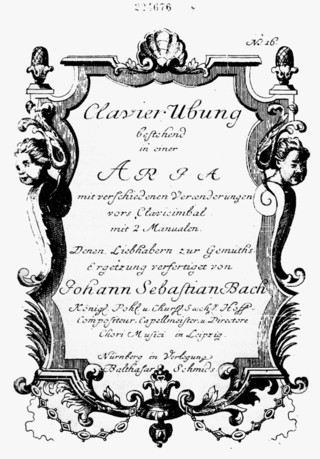
Laibach is a Slovenian and Yugoslav avant-garde music group associated with the industrial, martial, and neo-classical genres. Formed in the mining town of Trbovlje in 1980, Laibach represents the musical wing of the Neue Slowenische Kunst (NSK) collective, a group which Laibach helped found in 1984.

The Goldberg Variations, BWV 988, is a musical composition for keyboard by Johann Sebastian Bach, consisting of an aria and a set of 30 variations. First published in 1741, it is named after Johann Gottlieb Goldberg, who may also have been the first performer of the work.

In music, the BACH motif is the motif, a succession of notes important or characteristic to a piece, B flat, A, C, B natural. In German musical nomenclature, in which the note B natural is named H and the B flat named B, it forms Johann Sebastian Bach's family name. One of the most frequently occurring examples of a musical cryptogram, the motif has been used by countless composers, especially after the Bach Revival in the first half of the 19th century.

The Art of Fugue, or The Art of the Fugue, BWV 1080, is an incomplete musical work of unspecified instrumentation by Johann Sebastian Bach. Written in the last decade of his life, The Art of Fugue is the culmination of Bach's experimentation with monothematic instrumental works.
Karl Richter was a German conductor, choirmaster, organist, and harpsichordist.
Arthur Emil Helmut Walcha was a German organist, harpsichordist, music teacher and composer who specialized in the works of the Dutch and German baroque masters.

Fantasia contrappuntistica(BV 256) is a solo piano piece composed by Ferruccio Busoni in 1910. Busoni created a number of versions of the work, including several for solo piano and one for two pianos. It has been arranged for organ and for orchestra under the composer's supervision.
Gerd Zacher was a German composer, organist, and writer on music. He specialized in contemporary compositions, many of which feature extended techniques, and are written in graphic or verbal scores. He interpreted the scores of numerous contemporary composers, including John Cage, Juan Allende-Blin, Mauricio Kagel, György Ligeti, Hans Otte, Luis de Pablo, and Isang Yun. He is also known as an interpreter of the works of Johann Sebastian Bach.
Zoltán Göncz is a Hungarian composer who often applies archaic forms and complex structures in his compositions.

Adolf Friedrich Hesse was a German organist and composer.
Lionel Rogg is a Swiss organist, composer and teacher of musical theory. He is best known for performing the music of Johann Sebastian Bach, whose complete organ works he has recorded three times.
The Pascal Quartet was a French string quartet musical ensemble which took shape during the early 1940s and emerged after World War II to become a leading representative of the French performance tradition. It was named after its founder, the viola player Léon Pascal, and was occasionally termed the Leon Pascal Quartet.

Jazz Sébastien Bach is the debut album released by the Paris-based Swingle Singers. The album was a 1964 Grammy award winner for "Best Performance by a Chorus" and the group also won the 1964 Grammy award for "Best New Artist".
Erich Bergel was a German trumpet player and conductor.

Mit Fried und Freud, BuxWV 76, is the common name for a piece of funeral music composed by Dieterich Buxtehude as an homage to his father in 1674. The composer named the work Fried- und Freudenreiche Hinfarth when he published it the same year. It is a bundle of two compositions, the earlier Mit Fried und Freud, BuxWV 76a, a setting of Luther's hymn Mit Fried und Freud ich fahr dahin composed in 1671 reflecting the death of Menno Hanneken, and the elegy Klag-Lied, BuxWV 76b, an aria in seven stanzas. The incipit of the elegy, "Muß der Tod denn auch entbinden", translates roughly to "Even if death must separate us". It is one of few compositions published during Buxtehude's lifetime.

Joh. Seb. Bach's Werke is the Bach Gesellschaft's collected edition of Johann Sebastian Bach's compositions, published in 61 volumes in the second half of the 19th century. The series is also known as Bach-Gesellschaft edition. It is also referred to as Bach-Gesamtausgabe. It is a German-language edition: title pages and notes by editors are exclusively in German.









